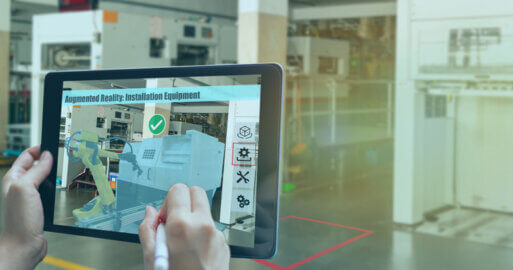Making Your Business Artificially Intelligent: How Machine Learning Makes Sense of Your Data and Lets You Automate

“Artificial general intelligence is a system which can perform well over a whole range of different tasks at the same level as a human being”
Colin Murdoch, Chief Business Officer, DeepMind1
The above quotation is the DeepMind definition of artificial general intelligence (AGI). Although we are not quite there yet, we are already seeing scenarios where artificial intelligence (AI) is outperforming humans, mainly due to its sheer speed. How do we teach a machine to perform to such a high level, what applications are we currently seeing, and how can you and your company unleash the power of AI?
Machine learning versus AI
In the not-so-distant past, the idea of machines making decisions, learning from data, and adapting to our needs seemed like a plot lifted from a science fiction novel. Fast forward to the present, and artificial intelligence (AI) has seamlessly woven itself into the fabric of our daily lives, shaping the way we work, play, and connect.
The ubiquity of AI is undeniable, and at the heart of this technological revolution lies the captivating realm of machine learning. From the algorithms powering our social media feeds to the intelligence steering autonomous vehicles, machine learning has emerged as the backbone of AI, quietly orchestrating the digital dance of ones and zeros.
The previous two paragraphs weren’t written by our SEEBURGER author. They were written in about 3 seconds by ChatGPT, an example of generative AI.
What is generative AI?
Generative artificial intelligence means that a machine is able to independently create content based on a user’s prompt. The generated content may be text, such as in the cases of ChatGPT, cohere and Gemini (previously Google Bard), or even images, such as DALL-E 2 and Stability AI.
In software development, generative AI is already being used to help developers produce cleaner, more efficient code by reviewing what they have written, highlighting bugs and suggesting potential fixes before issues can become bigger. The SEEBURGER BIS Platform has integrated ChatGPT to make using our mapping designer even easier for our customers with an iPaaS.
Generative AI is also used heavily in customer service chatbots. If you use a company’s online chat function to communicate with a firm, there is an extremely good chance that you are not talking to a human.
In 1950, scientist Alan Turing proposed what has since become known as the Turing Test. To pass, a machine must be able to communicate in a way which is indistinguishable from a human. No system has yet (fully) passed the Turing test, and we can see that in the difference in style between the initial two paragraphs and the remainder of the blog. However, it’s maybe surprising how often AI is found in our everyday business and private lives. Indeed, Mckinsey recently estimated that generative AI could lead to an average of 30% of working hours across industries becoming fully automated by 2030, with some industries able to automate over 50% of a typical workload2.
How is AI used in the business world?
Artificial intelligence is not only used to generate content. Its speed of processing and its ability to recognize patterns are used to detect fraud in the financial industry, to recognize and prevent cyberattacks in IT security, and to screen applicants in recruitment. AI is used to categorize and cluster customers in marketing, and applied in healthcare to search for certain illnesses in patients’ diagnostic material. In each case, AI can complete the work much faster than a human. In an extreme example from the world of biological research, the AI-driven AlphaFold was able to determine the folding structure of 2 million proteins within a couple of years, taking minutes per protein. Using traditional measures, folding the 2 million proteins would have taken 1 billion years3.
Artificial intelligence is heavily used in business analytics. This can be descriptive analytics, which reports on how a company is currently positioned and performing. This can be predictive analytics, predicting how a company and its performance will evolve if the business stays on its current track and trajectory. AI is also used for prescriptive analytics, investigating how to change to perform well into the future and making appropriate recommendations to a company’s decision makers.
But how has artificial intelligence got to this stage? This is where machine learning comes in.
What is machine learning?
Before you are able to use AI to complete a task, you have to teach the machine what to do. There are many different approaches to this, depending on the desired outcome. However, they all begin with data. As a rule, big data.
The amount of data varies by what you want the AI to ultimately do. However, to look at an extreme example, Gemini (previously Google Bard) is a large language model (LLM) that generates language on any subject. It was trained on a huge AI language model called LaMDA that contained 1.56 trillion4 words especially selected to teach the chatbot to engage in dialogue. And this currently only supports one language: US English.
So what approaches are there to machine learning? One of the machine learning models is called supervised learning.
What is supervised learning?
If you are training an AI application which involves categorizing or identifying certain variables, you will want to start with a supervised approach.
In supervised learning, the data is pre-organized into input-output pairs. The input contains certain features or attributes, while the output is a label or target value. The idea is that after enough exposure to the pairs, the machine learns to recognize what features are associated with what label.
Let’s look at how this works with a silly, non-business example.
Mickey wants to train AI to play a game: is it a mouse or a house? He starts by labelling pictures of either mice or houses as “mouse” or “house”. The input is the pictures whereas the labels “mouse” and “house” are the output.
Over time, the machine begins to recognize certain attributes connected to “mouse” or “house”. “Mouse” pictures tend to have two small eyes, whiskers and a lot of fur. “House” pictures have straight lines, are more solid, larger, and do not have eyes, arms or legs. They do have a door.
Mickey then gives the machine non-labelled input pictures of mice and houses. The machine uses its acquired knowledge of the features associated with either “mouse” or “house” to categorize the pictures into the two labels. If it is able to do this with some accuracy, it is now able to play the game independently. If it makes mistakes, Mickey can give it more training material, focusing on the attributes it struggles with.
What AI business applications are trained with supervised learning?
The above example used images as input. In business, a production firm may use supervised learning on pictures of production deficits to enable AI to view streamed camera images from an automation line and immediately discard defective products. A retail website may use supervised learning on images of clothing to enable AI to automatically categorize a new season’s clothes into type, color, style, length, or any other filter their customers may wish to use.
However, input doesn’t have to be graphical. A company may use supervised learning on text to enable AI to scan and categorize customer’s posts on social media and review sites into how they rate their experience in company. Known as sentiment analysis, this allows a company to flag and respond quickly to a negative review before their reputation has been damaged.
The input may be activity on a website. A streaming platform may use supervised learning to train AI to map what viewers have watched with further recommendations, while a retail platform may also use a consumer’s browsing and purchase history to make further recommendations through an omnichannel strategy.
Equally, a manufacturing firm may use sensor data from their production machines and IIoT devices as input to enable AI to recognize when a machine is liable to fail. Known as predictive maintenance, this ultimately saves a company a huge amount of money by preventing expensive unplanned downtime.
What is unsupervised learning?
Supervised learning is ideal if you want to map input data to defined outputs. However, life is not always that simple. Sometimes you have masses of data, know that there is gold in there somewhere, but it’s not immediately obvious where. This is where an unsupervised learning approach comes in.
In unsupervised learning, you start by running a number of algorithms through your mass of data. These may be clustering algorithms which group data by defined and non-defined shared attributes, and plot the data sets by similarity and difference to other data sets. These may be a number of mathematical algorithms to clean up the data and make its patterns and associations to other data groups more apparent. As patterns begin to crystalize, the algorithm intuitively adjusts its parameters and so learns to automatically capture meaningful associations. Remember, ‘unsupervised’ refers to the fact that you haven’t labeled what you want the machine to learn. Machine learning is a serious discipline where trained practitioners are able to intervene at any stage.
What AI business applications are trained with unsupervised learning?
Unsupervised learning is used to train AI to perform market segmentation. This involves dividing a heterogeneous market into distinct groups of consumers who have similar characteristics, needs, or behaviors. Unsupervised learning techniques let you identify meaningful segments without prior knowledge of customer preferences or demographics, and has frequently thrown up significant yet unexpected clusters not yet addressed by a company’s marketing strategy.
Unsupervised learning algorithms are also used to detect anomalies in various business domains. These include fraud detection, network security, and predictive maintenance. By modeling normal behavior patterns from unlabeled data, these algorithms can identify outliers or anomalies that deviate significantly from the norm, indicating potential fraud, security breaches, or equipment malfunctions.
However, AI gets particularly exciting when unsupervised learning is used to help train a large language model (LLM) for generative AI.
How do you train a large language model?
AI is also used to generate and manipulate text. This may be a chatbot reducing the pressure on a company’s customer service team, automatic translation of a company’s website, or generating copy.
Generative AI doesn’t understand what it is creating. Although it can write an introduction to an article on machine learning (and could even write a semantically correct article in just a couple of seconds more), it doesn’t actually understand how machine learning works, nor does it have an opinion on it. Instead, the LLM has been trained on several billion words with unsupervised learning algorithms to work out what word is likely to come next. This involves identifying things such as a dependent preposition (basically, why we say interested in AI and not interested for AI or another variation). Or recognizing collocations (why, when talking about a successful deal, we say close a contract and not do a contract or other variations). Or, identifying that statistically the most common word to follow “walk the” is “dog”.
A breakthrough enabling this technology was the transformer architecture developed by Google in 2017. Essentially, this lets you analyze a word in context. Once a word has been successfully decoded it is plotted on a vector, essentially a position on a map, in relation to all the other words in that language.
Let’s take our earlier examples of mouse and house. Although the words rhyme, they have very different meanings. Mouse is placed between the axes near words like rodent, hamster and gerbil whereas house is plotted between the parameters near words like, home, abode, domicile, residence, cottage, flat, and mansion.
However, these clustered words are not necessarily synonyms. Abode and domicile and residence are more formal or legal depictions of where someone lives, while cottage and mansion denote a small and large type of house respectively. To differentiate between these nuances, a 2D graph with two parameters suddenly isn’t enough. An average LLM needs a multidimensional model with 10005 parameters, whereas LamDa, the LLM behind Gemini, has 137 billion6.
By the way, this is also how machine translation works. Once you have plotted multidimensional models for two languages, the machine just needs to see what word is plotted on the same coordinate in the second language. Purely by comparing coordinates, a machine will know that the German phrase die Maus wohnt in einem winzigen Haus is translated as the mouse lives in a tiny house.
How do I harness AI in my business?
First of all, you have to work out is where is my data and how am I going to get that data in a place to make those predictions? And that’s the biggest problem for all companies to solve is how do I get it out of my financial management system… and what external data sources could I have which can help me…how do I connect into manufacturers’ systems…
Colin Murdoch, Chief Business Officer, DeepMind7
How do I get my data to where it needs to go?
There are many ways to access machine learning environments and prebuilt AI models. However, whether you are retrieving and collating your own data, training your own AI on your own data, using your own data in a provider’s cloud-based machine learning environment, or integrating a provider’s cloud-based AI solutions to automate your own systems, one thing is clear. There is a lot of data to get to the right place.
The SEEBURGER BIS Platform is an integration platform with several capabilities that let you move data from anywhere to anywhere. The managed file transfer capabilities on the BIS platform let you move huge volumes of confidential data in real time to a data lake or any other endpoint, including an API connection. The EAI/A2A capabilities let you connect to other applications while the API capabilities, including extremely robust API management, mean that if you are accessing AI services via APIs or using APIs to move your own data from system to system, you can control and keep track of the performance, security and access rights to and from each API.
As more and more AI services are being offered as a SaaS, the EAI/A2A capabilities on the platform get you connected quickly. These include an impressive collection of secure, functionality-rich connectors that are being constantly being added to and updated to keep pace.
Accessing the machine learning and AI tools on the public clouds
The three main hyperscalers offer a range of AI services to their cloud tenants, often with a free low-volume version. The BIS Platform is available as an iPaaS which can easily be hosted from the public cloud of your choice, whether AWS, Microsoft Azure or Google Public Cloud. Put the BIS Platform where your other applications and data are to avoid outgoing data charges and potential latency going in and out of the public cloud.
As well as MFT, API and A2A capabilities, the BIS Platform also has IIOT, EDI and automation capabilities. Available as fully managed services on the SEEBURGER Cloud, an iPaas on a private or public cloud or an on-premises installation.
About SEEBURGER
Why SEEBURGER? One central platform, one experience, all integrations, all deployment models. Our BIS Platform enables seamless connectivity of applications, people and processes, whether in the cloud, a hybrid environment or on-premises. With the BIS Platform, anyone can design simple to complex integrations on their own, helping to strengthen their company’s digital ecosystem.
Webcast On-Demand
There are several useful commercial and open-source AI tools that provision their own API to integrate with your systems. However, will this be secure enough for your needs? Take a look at our webcast on demand on API Management to discover how the SEEBURGER BIS Platform helps improve the security of any APIs in your ecosystem
Watch now1 Quote taken from Davis, Evan. (2023). “Powered by AI”. The Bottom Line. 23rd Feb 2023. [Podcast]. [Accessed 25th January 2024]
2 McKinsey Global Institute. (2023). Generative AI and the future of work in America. [Online]. McKinsey.com. Last Updated: July 26, 2023. [Accessed 4th February 2024].
3 Royal Institution Christmas Lectures. (2023). The Truth about AI:2. My AI Life. BBC4, 26th December 2023.
4 Cornell University. (2022). LaMDA: Language Models for Dialog Applications. [Online]. Cornell University. Last Updated: 10th February 2022. [Accessed 5 February 2024].
5 Royal Institution Christmas Lectures. (2023). The Truth about AI:1. How to Build an Intelligent Machine. BBC4, 26th December 2023.
6 Cornell University. (2022). LaMDA: Language Models for Dialog Applications. [Online]. Cornell University. Last Updated: 10th February 2022. [Accessed 5 February 2024].
7 Quote taken from Davis, Evan. (2023). “Powered by AI”. The Bottom Line. 23rd Feb 2023. [Podcast]. [Accessed 25th January 2024].
Thank you for your message
We appreciate your interest in SEEBURGER
Get in contact with us:
Please enter details about your project in the message section so we can direct your inquiry to the right consultant.
Written by: Melissa Kuhnert
Originally from the UK, Melissa Kuhnert joined the writing and editorial team at SEEBURGER at the end of 2020. With degrees in language and business, and a long interest in technology and effective communication, Melissa spends much of her time at SEEBURGER translating and creating blog posts for our English-language readers. Before joining SEEBURGER, she enjoyed a long career offering tailored, in-house English language training to corporate clients in mainly technical industries, and quite a lot of writing and translation. She estimates that she has taught in over 100 different companies, 5 universities, and toured so many clients’ production facilities, she owns her own steel-capped boots and safety glasses. Outside of work, Melissa enjoys exploring Germany, reading, watching British comedies, and firmly believes that a pun is its own reword.





